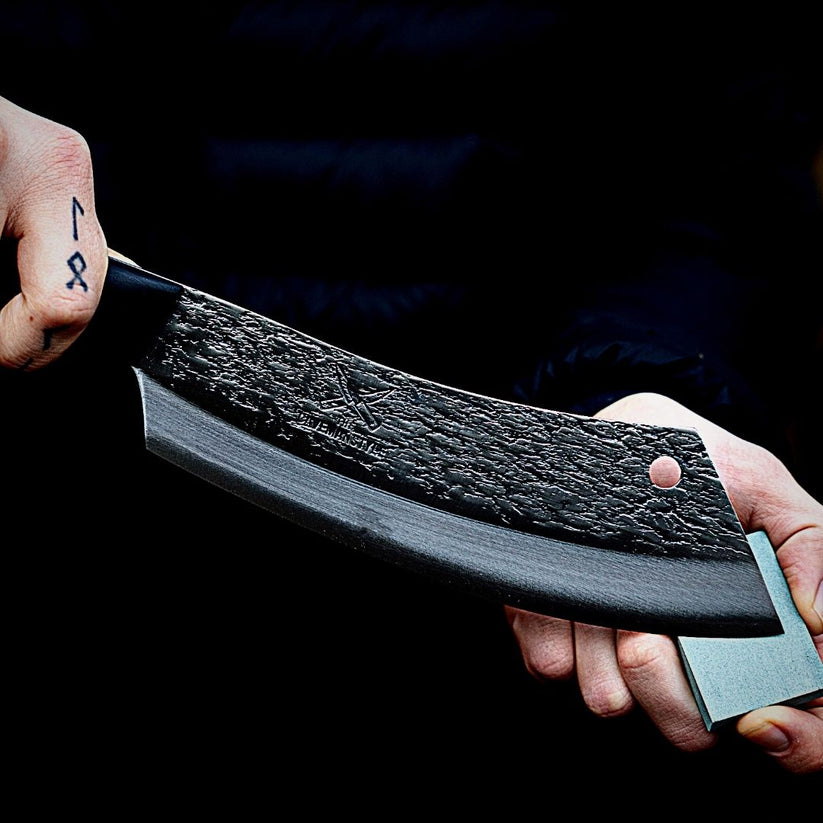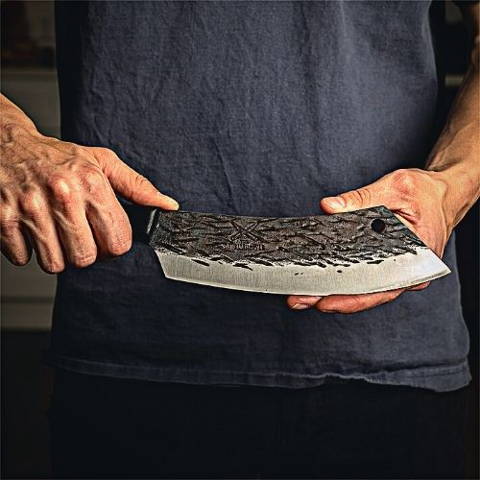Cleaver knives are a timeless kitchen tool that has seen an evolution from its historical origins to its modern reinterpretations. Understanding the perfect harmony between blade, balance, and technique is crucial for navigating the world of cleavers. Experienced chefs and craftsmen provide valuable insights that can help uncover the artistry behind choosing the ideal cleaver for your kitchen, unleashing a new level of culinary finesse in every slice.
Whether you are a professional chef or a home cook, understanding the uses and differences of cleaver knives in different countries is essential. Testing meat cleavers and learning what works best for your needs is also crucial. In this article, you will learn about the different types of cleaver knives, how to choose the right one for your needs, and how to use it to achieve the best results.
Key Takeaways
- Understanding the perfect harmony between blade, balance, and technique is crucial for navigating the world of cleavers.
- Learning about the different types of cleaver knives and how to choose the right one for your needs is essential.
- Testing meat cleavers and learning what works best for you is key to achieving the best results in the kitchen.
What Is A Meat Cleaver, And What's It Used For?
A meat cleaver is a heavy-duty knife with a thick, rectangular blade that is commonly used in butcher shops and professional kitchens. The blade is designed to have a forceful blow and precise cutting action, making it ideal for splitting thick cuts of meat, thin or soft bones, and sinew. Meat cleavers are versatile tools that can also be used for pounding, mincing, dicing, and slicing a variety of other foods. They come in different types, such as the Chinese cleaver, which is suitable for slicing, dicing, and chopping vegetables and cutting through bones and meat.
Comparison Of Cleaver Knives In Different Countries

Cleaver knives are used across different countries, and while they may share some similarities, they are not all the same. Here is a comparison of some cleaver knives used in different countries:
-
Chinese Cleaver Knife: This knife is commonly referred to as a chopper or Chinese cleaver. It has a rectangular-shaped blade and is much thinner than other cleaver knives. It is mostly used as a general-purpose knife for slicing boneless meat and vegetables.
-
Japanese Cleaver Knife: Locally known as a Deba bōchō, this knife is similar in terms of cross-section thickness to the Chinese cleaver knife. However, it is more similar to boning knives and is commonly used in decapitating fish heads and deboning fishes.
It is important to note that there are other types of cleaver knives used in different countries, but the Chinese and Japanese cleaver knives are perhaps the most well-known.
Testing Meat Cleavers
The Tests
The performance quality and results of meat cleavers have been thoroughly assessed to replicate demanding use in environments such as butcher shops and professional kitchens. The objective is to evaluate their performance, durability, and suitability for various cutting and chopping tasks. The tests also consider weight distribution, comfort in the chef’s hands, and the safety of single-handed use.
The Best Overall Meat Cleaver - CAVEMAN CLEAVER 2.0

The Caveman Cleaver 2.0 is described as a kitchen knife that integrates strength, balance, and elegance. Crafted from softer stainless steel, it undergoes hardening to reach optimal quality. The cleaver features a sharp, rust-resistant blade and a fortified shape suitable for tackling tough cuts. Its rosewood handle and style to this renowned kitchen utensil.
Key Specifications:
- Crafted using traditional Japanese blade-making techniques for high-quality results.
- Additional San Mai technique offers extra protection against corrosion.
- Extremely sharp and rust-resistant, designed to last a lifetime.
- Perfectly balanced and effortlessly slices through challenging cuts.
Another Fantastic Cleaver - Caveman Cleaver 1.0

The Caveman Cleaver features a breathtaking blade with mountain range designs and a wood handle, making it a masterpiece perfect for nature lovers. Crafted using German 1.4416 stainless steel, the blade exhibits remarkable resistance to rust and corrosion, remaining extremely sharp and capable of tackling resilient roots and vegetation.
Key Specifications:
- Specially crafted using German 1.4116 stainless steel for corrosion resistance.
- Razor-sharp and sturdy in handling resilient root vegetables with ease.
- Full tang and perfectly balanced in weight, offering ease in chopping.
- Ideal for mincing, dicing, and slicing a variety of meat and vegetables.
A Great, Precise Cleaver - Rocking Cleaver
The hand-crafted Bushcraft Rocking dubel handel Cleaver stands out as an exceptional creation in the realm of culinary tools. Carefully crafted with the perfect balance of hardness, flexibility, and resilience, this cleaver enhances the cooking experience and makes meal preparation a true pleasure.
Key Specifications:
- Hand-forged construction ensures high quality and durability.
- The blade is balanced in flexibility, hardness, and resilience for optimal performance.
- Ideal for a variety of cutting tasks within the kitchen with a razor-sharp blade.
- Designed for durability and sharpness longevity with a full tang blade..
What We Learned
Sharper Blades Cleaved Cleanly
Through extensive testing, it has become clear that cleavers with sharper blades provide better cleaving performance. The exceptional sharpness of the blade allows for effortless cutting through meat and other culinary items. This characteristic also provides less effort for the handler to put in, ensuring better precision and minimizing damage to the blade, the food, and the wielder.
Size Isn't Everything: Bigger Wasn't Necessarily Better
Contrary to popular belief, bigger does not always mean better performance. Smaller, well-designed cleavers have been shown to provide ease in handling and optimize functionality speed, making them outperform larger and heavier counterparts through efficiency and maneuverability.
The Advantages of a Subtle Blade Curve
A subtle blade curve has several distinct advantages. Firstly, it provides enhanced control during cutting or slicing motion, improving accuracy and minimizing strain on the wielder. Secondly, the curve provides better contact with the material, further improving the cutting/slicing process.
A Solid Handle Made A Difference
A strong and solid handle is crucial for cleaver usability. It provides a comfortable grip, which minimizes discomfort and fatigue, enhances control and precision, and contributes to better outcomes while preparing food.
What's The Trick To Picking A Cleaver Knife?
When it comes to picking the perfect cleaver knife, several factors come into play. The material, blade length, blade thickness, blade weight, and comfortable handle are crucial considerations. In this section, we'll delve into each of these factors and explore what to look for when picking a cleaver.
Material For A Cleaver
The material of a cleaver is a crucial factor to consider when picking the right one. High-carbon stainless steel is an excellent choice for its durability and sharpness. It combines corrosion resistance with a keen edge, ensuring prolonged cutting prowess. Look for blades with proper heat treatment for added strength. A sturdy, ergonomic handle crafted from materials like hardwood or composite resins offers optimal grip and control. The synergy between top-notch steel and thoughtfully designed handles ensures your cleaver becomes a seamless extension of your culinary artistry, enabling you to master the delicate balance between power and precision.
Blade Length
The blade length of a cleaver ranges between 7 to 8 inches (178mm to 200mm). The length serves the purpose of cutting through thick meat and covering a wider area of the cut. There are also some cleavers that range around 9 to 10 inches long.
Blade Thickness
The blade thickness is one of the major features of a cleaver. This feature serves the purpose of delivering a successful cut, slice, or chop over a wide range of meat and bones. A thicker blade is more durable and can handle tougher tasks.
Blade Weight
The blade weight is another crucial factor to consider when picking a cleaver. Cleavers are designed to have a balanced weight for comfort and maneuverability, but they generally weigh around 300g to 900g, which are suitable for mincing meat and breaking down chickens and bone. A heavier blade can provide more force and momentum, making it easier to chop through thicker cuts of meat and bones.
Comfortable Handle
A comfortable handle is essential for prolonged use of a cleaver. The handle should be sturdy and made of quality materials like hardwood. It is important to check out each cleaver's handle features and specifications to find the right handle. A well-designed handle provides optimal grip and control, enabling you to use your cleaver with ease and precision.
In summary, picking the right cleaver depends on several factors, including the material, blade length, blade thickness, blade weight, and comfortable handle. By considering these factors, you can select the perfect cleaver that suits your needs and preferences.
How Chefs Use Our Cleaver
Our quality cleavers are designed to fit all sorts of chefs who are seeking professionally-crafted materials for their cooking endeavors. Here is how chefs use our cleavers in their cooking.
Slicing Through Boneless Meats
When it comes to boneless meat, our cleavers are the perfect tool for the job. The sharp blades are capable of slicing through meat with ease, making it an ideal choice for chefs who need to prepare large amounts of meat quickly. It is important to note that while our cleavers are strong enough to slice through bone, we do not recommend using them for this purpose, especially for larger animals. Repeatedly cutting into something that hard can cause damage over time, not only dulling but also nicking the blade.
Splitting Open Tough Vegetables
Cleavers are not just for tough meat only, the strength and sharpness our cleavers provide are also excellent in tackling tough vegetables, cracking them open with ease. Our Nomad Cleaver is specifically designed to remain sharp while it cuts through tough root vegetables with ease.
Crushing Garlic
Cleavers can be used to crush certain spices and flavorings, and many chefs use the flat phase of the cleaver to crush garlic. Our cleavers' balanced weight and resilience provide minimal ease in crushing garlic.
The Rocking Method
Our cleavers are designed to adapt to modern cooking methods while providing ease and minimization of effort put through usage. This would include cutting methods such as the rocking cutting method, which is a popular technique used by many chefs. The rocking motion allows for a more efficient and precise cut, making it easier to chop herbs, vegetables, and meat.
Transferring From Your Cutting Board
Cleavers have a thick, strong, and smooth surface where it can effortlessly move the minced ingredients from one pot to another without making drag or damaging the chopping board. This makes it easy for chefs to move ingredients around the kitchen without having to worry about damaging their equipment or losing any of their hard work.
Good To Know
The Hardness Rockwell scale is a measuring method used to measure the hardness of certain materials. Knife sets undergo these tests to assess their strength and hardness in penetrating specific surfaces. The results show that the knife sets are highly crafted to perform beyond expectations. This means that the knives are made of high-quality materials that can withstand wear and tear. The strength of the knives is a testament to their durability and longevity. It is important to note that these tests ensure the quality of the knives and their ability to perform well in any kitchen.
Ready To Shop?
The caveman style offers a wide range of high-quality crafted cleavers to suit your taste and preferences. Visit their official website to checkout and more! You can also check out their best sellers. Enhance your cooking performance in the kitchen with one of their quality cleavers.
Related Posts:
FAQs
Why Do Some Cleavers Have Holes?
Some cleavers have holes, known as "dimples" or "granton edges," which create air pockets between the blade and the meat to reduce friction and prevent food from sticking to the blade. This feature is particularly useful when cutting large pieces of meat.
Do You Need a Meat Cleaver?
Meat cleavers are essential for breaking down large cuts of meat or bone. While task-specific knives such as boning knives and fillet knives can also be used for these tasks, meat cleavers are designed specifically for heavy-duty chopping and tougher cuts.
Is a Butcher Knife a Cleaver?
While both butcher knives and cleavers are used for butchering tasks, they serve different purposes. Butcher knives are versatile, used for trimming and slicing meat to specific proportions, while cleavers are designed for heavy-duty chopping and tougher cuts.
How Do You Sharpen a Meat Cleaver?
There are several tools and techniques that are specifically designed to sharpen meat cleavers and other cutlery. Whetstones and honing rods are commonly used to maintain the blade's sharpness and effectiveness throughout its lifetime. It is recommended to use a sharpening tool that is appropriate for the type of blade you have.
In conclusion, understanding the purpose of a meat cleaver and how to maintain it is essential for any home cook or professional chef. By using the appropriate tools and techniques, one can ensure that their meat cleaver remains sharp and effective for all their chopping needs.

2 comments
I would like to see full sets please ….
Hope you right I well fine out?